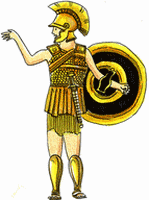Maps of the Antique
Mediterranean Sea
 Greece Greece
 Attic Attic
 Corinth Corinth
 Magna Graecia Magna Graecia
 Apulia Apulia
 Daunia Daunia
 Gnathia Gnathia
 Campania Campania
 Some dates Some dates
 Archaeological sites Archaeological sites
 Pottery and ceramics Pottery and ceramics

|
CAMPANIA: ARCHAEOLOGICAL SITES

|
Campania is exceptionally rich in Roman archeology, since Pompeď and Herculanum are on its territory. The eruption of Vesuvius in 79 was a real providence for the archaeologists!
Concerning the older sites which interest us here - greek, etruscan or samnite - they have almost all disappeared under the flourishing architecture of the Roman cities. With however one exception, which also took advantage from exceptional circumstances. And what an exception, since we mean here the town of Paestum (ancient Poseidonia), with its three large and almost intact classical temples, and other easily recognizable monuments.
|
Here, it is not a volcano which saved the city: it is the silting of the littoral and of the city itself, which became a marsh already at Roman times - and moreover the insalubrity which accompanied it, with the appearance of the malaria towards 500 of our era. Thanks to this other "providence", Paestum is today a major archaelogical site in Magna Graecia.
Its exceptional museum is as the same high level than the site - and the only one to present a complete image of the Etruscan and Greek Campania. The archaeological museum of Naples, though extraordinarily rich, is mainly devoted to the excavations of Pompeď and Herculanum.
The other areas show only rare vestiges.
In Cumes, we can evoke the acropolis and, in the sacred enclosure, the temples of Zeus and Apollo. Also the cave of Sybille and the thermal baths located downhill.
Other vestiges, less evocative, may be seen in Caserte (samnian necropolis), Naples (scattered traces of the greco-roman cities of Parthenope and Neapolis), Pontecagnano (etruscan ruins, museum) Roccadaspide (vestiges of a Greek sanctuary), Sarno (ruins of an hellenistic theatre) and Eboli.
|
|

















